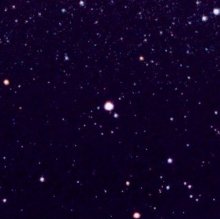
See the full-resolution image and more on polar stars in the Polar Project.
 |
Polaris is centered in a six-degree-wide field of view that shows
a variety of "polar stars." Lamdba Ursae Minoris is the reddish
star up and to the right of Polaris. Roughly between them lies the
North Celestial Pole, around which they all seem to revolve.
Yildun (Delta UMi) is the
brighter of the pair at the upper right corner.
See the full-resolution image and more on polar stars in the Polar Project. |